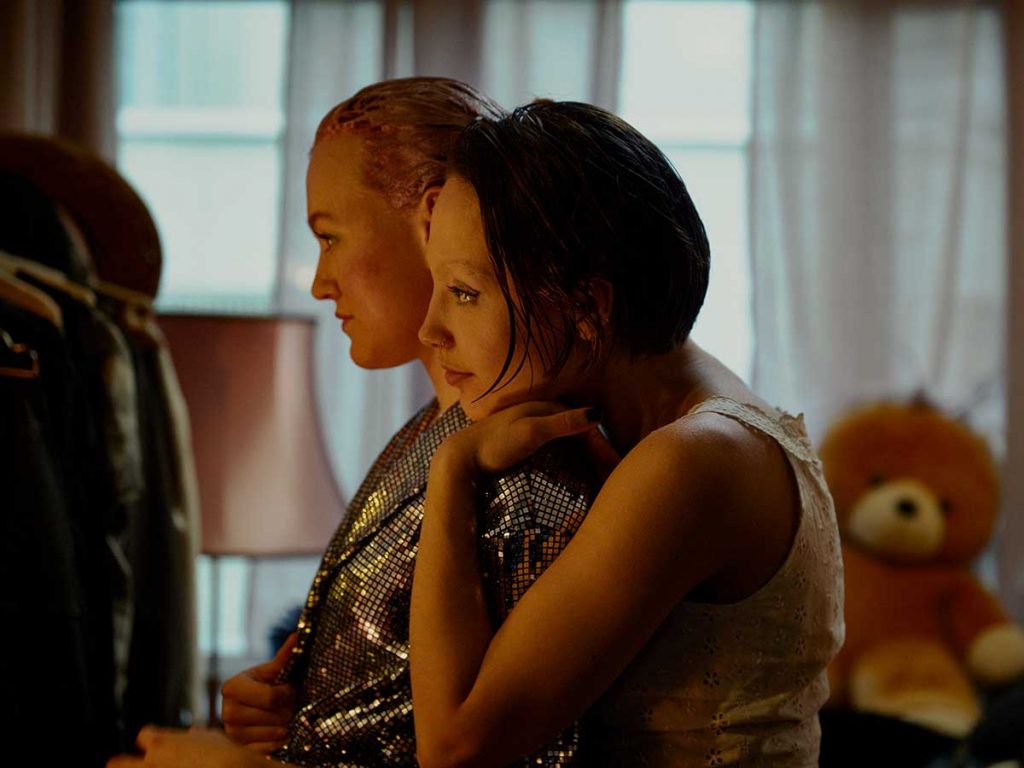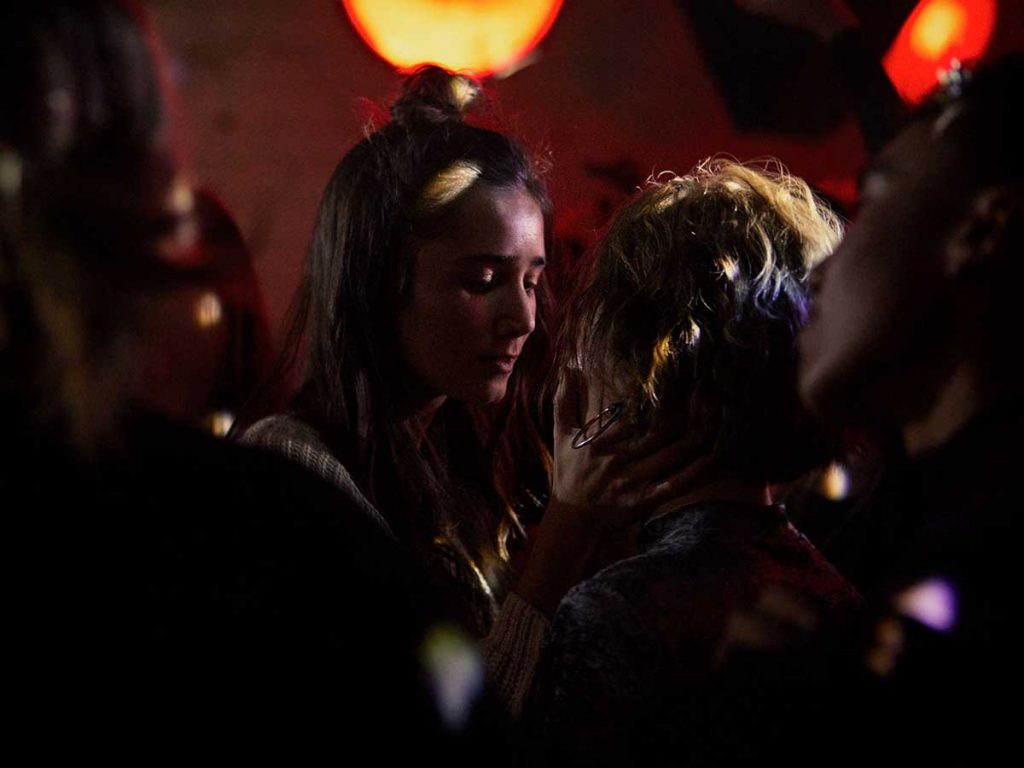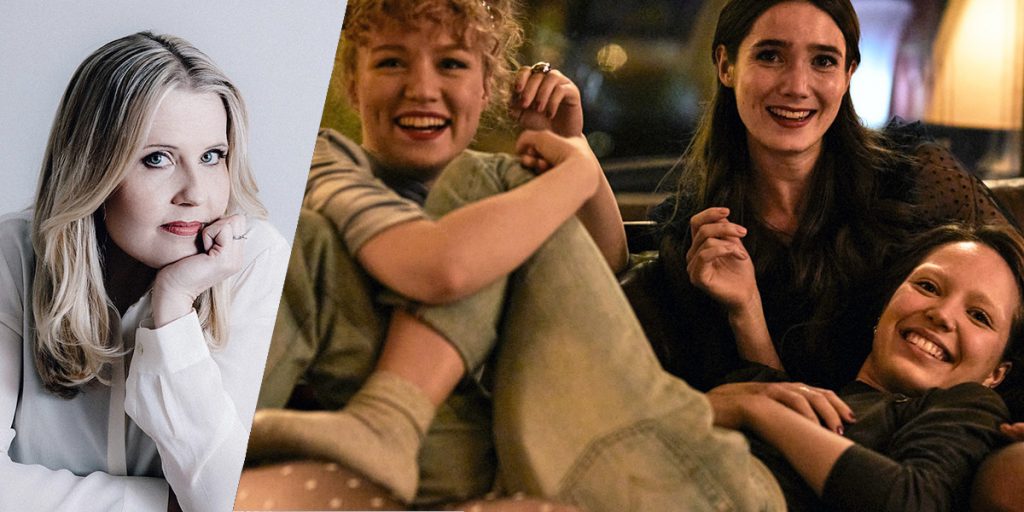Girls Girls Girls ‘s director Alli Haapasalo tells us about the film’s messages, challenging gender bias and clichés, casting and aesthetic choices, winning the Audience Award at Sundance and more.
Alli Haapasalo ‘s Girls Girls Girls (Tytöt tytöt tytöt) is not your typical coming of age story. The film mainly shows us a snapshot of the life of three girls – best friends Mimmi (Aamu Milonoff, of Karppi) and Rönkkö (Eleonoora Kauhanen, in her first ever on-screen role), and “outrageously good” ice skater Emma (Linnea Leino, of Pahan Väri) – and delves into many subjects, from the uncertainties and anxieties that come with being a teenager to the discovery of one’s identity and sexuality, to the power of female frienship, but it does so with an authenticity that is rarely found in cinema these days.
Masterfully brought to life by the film’s three leads, Emma, Mimmi and Rönkkö are not just young girls but first and foremost human beings: even if they’re still growing up and figuring out who they are, they are still complex individuals with needs and desires, and they aren’t ashamed to express themselves. As we follow their journeys in the film, we get to experience a beautiful, realistic friendship between Mimmi and Rönkkö, but we also follow them as individuals, the former navigating a new romance with Emma and the latter embarking on her own journey while trying to connect with members of the opposite sex in various ways.
As all of this happens, we soon start to realize that we’ve all been Mimmi, Emma and Rönkkö at some point in our lives, and we’re given the chance to experience these moments again – only, not on our own but with the film’s complex, multilayered protagonists. This makes Girls Girls Girls not only a hugely enjoyable, gripping film about love, sex, life, and womanhood, but also an extremely relevant, empowering experience that challenges gender bias and paints a realistic picture of (young) women at their most authentic.
In the occation of Girls Girls Girls ‘s World Premiere at the Sundance Film Festival, where it won the Audience Award in the World Cinema Dramatic category, we spoke with director Alli Haapasalo on Girls Girls Girls ‘s origins and several messages, how the film challenges clichés in its representation of young women, how the cast took ownership of their characters, how a realistic soundscape was crafted with “abrupt changes of emotion” and “conscious imperfections,” audiences’ reactions to the film, and more.
Alli Haapasalo on Girls Girls Girls‘ Origins, Story, and Sundance Premiere
Congratulations for Girls Girls Girls ‘s premiere at the Sundance Film Festival! The film has had a very successful festival run this year: what does it feel like to be able to show it to international audiences?
Alli Haapasalo: I’m overjoyed! The Audience Award is extra meaningful to me, as it makes me feel directly connected to the people we made this film for. Since our premiere last Monday we’ve been showered with messages about the film, and one thing that keeps coming up is the fact that people feel like they’ve seen themselves on the big screen. One audience member wrote that this feels like a movie she had been waiting for all her life. That left me speechless. My main goal was to create a film that represented girls in a more complex and relevant way than they often are on screen. So this audience response leaves me both humbled and ecstatic.
The whole Sundance experience has been truly remarkable. You know, we may have been all over the world physically, but we did come together as a community of filmmakers and film lovers and were able to share a powerful experience. I watched all of the films in the World Cinema Dramatic Competition and many others from other series, and found it so inspirational to see the work of talented colleagues from all over the world. Talks and webinars were very inspiring. And I have developed a huge crush on Tabitha Jackson, the festival director. She is so wise, charismatic and funny.
How did this project come to life?
Alli Haapasalo: Screenwriters Ilona Ahti and Daniela Hakulinen approached me with a treatment already in 2014. I got attached immediately, because it was evident that they had a very fresh take on a story about adolescence. It became a mission for me to depict girls in a more complex, realistic and relevant way than we often see on screen. And to create a film where girls are valued as exactly who they are.
How would you describe Girls Girls Girls?
Alli Haapasalo: Girls Girls Girls is a film about the need to be seen, about navigating that difficult liminal age when you’re right at the cusp of womanhood, fluctuating between childhood and adulthood, about experiencing new and intense emotions for the first time, and ultimately about trying to draw your own contours. The story follows these girls on three consecutive Fridays, during which two of them, Mimmi and Emma, experience the earth moving impact of falling in love, while the third, Rönkkö, goes on a quest for something she hasn’t yet experienced: pleasure.

Girls Girls Girls‘ Portrayal of Girls & Casting the Film’s Protagonists
I absolutely loved the characters of Mimmi, Rönkkö and Emma, and it’s so refreshing to see young women portrayed in a film first and foremost as human beings with desires, opinions, and a sense of self-worth.
Can you talk about the portrayal of young women in your film, and the gender bias you wanted to challenge?
Alli Haapasalo: I appreciate that, and I love that you point out sense of self-worth. My main goal was to have the characters do everything they do on their own terms. They’re not defined by boys or adults, and they don’t live to please other people.
We have become accustomed to girl-characters who are often quite one-sided, there to fulfil a functional role in the story. And of course, often girls are just objects. It was key for us to have girls take center stage, and create characters who were fist and foremost complex human beings. We also wanted to go agains clichés in representation. When you really start to ask yourself, how we looks at girls – both on screen and off – you find a lot of bias in your mind. I have it, we all have it, and we have to actively unlearn it. An example: the writers and I had in an earlier screenplay draft included a scene, where two of the girls get into a dangerous situation with a sleazy guy. The idea was that they escape triumphantly and it makes a bond between the girls. But we then realised that we were enforcing a stereotypical representation of “girl as victim”. There are many iterations of this in movies, and often girls who do what they want, end up at minimum in danger. We realised that we really didn’t want to repeat that narrative. In the final Girls Girls Girls, girls don’t get punished, shamed, belittled, patronized or even warned. They explore their identities completely free from that, and nothing stops them from being who they are. I’m well aware of the fact that the world isn’t like that to most girls. But I hope that choices like this on the big screen can help create change in the real world too.
Both Mimmi, Rönkkö and Emma’s individual struggles and journeys and the dynamics between them feel so authentic and relatable. How did you cast Aamu Milonoff, Eleonoora Kauhanen and Linnea Leino to play your three protagonists?
Alli Haapasalo: I knew that this film lives or dies with the cast, so I did en extensive casting process and moved really slowly with it, because I needed time to really think it through. I wasn’t only casting individuals, but I was casting a trio – and the pieces of the puzzle had to not only fit in perfectly, but also complement each other. Right after the final round of callbacks, I knew that this was my band! Aamu, Eleonoora and Linnea are all simply amazing.
How did you work with them to craft their respective characters and create this wonderful chemistry?
Alli Haapasalo: I like to rehearse a fair amount before the shoot, and especially now, with young actors, it was key. I spread the rehearsals out over the course of three months, so we had time to build trust during the process. Right from the get-go, I asked them to give me notes on the screenplay and not be shy with requests, so they would take ownership of their characters. We broke down every scene and beat together, then rehearsed all the key scenes. We talked and talked and talked – about youth, our shared experiences, differing experiences, girlhood, relationships, parents – you name it. And every intimate scene was choreographed and rehearsed with intimacy coordinator Pia Rickman. Aamu, Eleonoora and Linnea embraced the extensive prep full on, and that’s what made it all work. There was a great sense of everyone working on a shared goal and caring deeply about the project.
One reviewer wrote that Aamu Milonoff could have chemistry with a rock. We all cracked up so hard at that comment, which is totally true by the way. I told Aamu that I’ll print a t-shirt for her with that on the back. Linnea Leino learned to skate for the role: she trained hard for three months, so she would pass as a top lever figure skater. And can you believe that this is Eleonoora Kauhanen’s first ever on-screen role? She is a natural.

Conveying Intimacy Through Sound Design
What really stood out to me in the film is how it effortlessly switches between intimate, quiet scenes and louder moments that reflect your characters’ moods in specific moments, and I feel that the sound design really helps convey emotion.
Can you talk about some of the choices behind the film’s sound design?
Alli Haapasalo: I’m glad that you picked that up, because this was one of my very early aesthetic choices for the film. I wanted there to be abrupt changes in tempo and mood, because I think that adolescence is all about abrupt changes of emotion. I also wanted to keep things moving all the time – both people and the camera – until we quiet down for the moments of intimacy or self reflection. My DP Jarmo Kiuru and I had this motto, that “movement is norm, and being still is a special effect.” Editor Samu Heikkilä embraced this and the idea of abrupt changes of mood in the picture editing – he has fantastic rhythm. And sound designer Anne Tolkkinen made it all very dynamic with her magic.
Anne and I have worked together on almost all of my films since film school, so we have a body of work together. We usually opt for subtlety, but in this film we knew we had to do the opposite. Teenagers are not subtle! It was all about creating a rich, dynamic and realistic but amplified world of sound, where changes are not smooth at all. There is this one direct cut where a Finnish rap song suddenly blasts so loud that I still jump pin my seat – and I love it. Some people might think it’s a mixing mistake, but it’s intentional. Conscious imperfections were a big thing for us, because I wanted the film to reflect a real, unpolished and human world, where nothing is perfect. I kept repeating to everyone at every stage of production that life can be found in imperfections.
Obviously music is a very big part of the sound design in this film. There is a lot of pre-recorded music in the film, which was all found by music supervisor Jan Forsström. As our budget was modest, but our need for songs enormous, Jan had to find very fitting songs that would sound like a million bucks, but not cost that. And he did! I love this soundtrack.
Trusting the Story of Girls Girls Girls
What was the main challenge for you when making the film?
Alli Haapasalo: Besides the obvious answer of time and money being sparse, it was trusting the story. And when I say that, I don’t mean trusting the screenplay by Ilona and Daniela. I loved that! And I loved the fact that they were able to resist going for a more traditional, plot driven story with a familiar arch, and stay closer to a character study or a fragment of life. But, even if I loved the screenplay, it was still hard to shut down the imaginary voices of viewers, script commentators and critics in my head saying that the story wasn’t “big enough”. You know, women filmmakers have for so long heard that their stories aren’t significant enough – and we had received that note from many in the development phase also. It had been a hard script to read, if you couldn’t picture how it would feel on the big screen.
The text was wonderfully porous and left a lot of space for the actors and the power of cinema. And that was wonderful! There was no hiding behind complex plot twists or exciting action. So I knew that I had to be extremely specific with every choice in order for the film to work – if anything was generic, it would be the death of the film.
Even in the editing room I kept asking Samu [Heikkilä] if the film was “big enough”. He looked at me and said: “Come on, it has the whole universe in there.”
Girls Girls Girls‘ Message and What’s Next for Alli Haapasalo
What message would you like people to get from Girls Girls Girls?
Alli Haapasalo: There are several positive messages. First, that sexuality is a normal, sometimes problematic, part of life, and everyone should be allowed to explore it safely. Girls are sexual beings too, and they don’t deserve a punishment for desiring. Also, confirming consent is not difficult, as the characters show.
The story of Emma and Mimmi is a love story between two girls, but sexual orientation is never mentioned, because it’s a non-issue to everyone, as it should be in real life.
And finally, the message is to really see girls, fairly and equally, not as lesser human beings. Sounds like a total no-brainer, right?
Finally, what’s next for you? We’d love to hear about your future projects.
Alli Haapasalo: I’m developing two feature films and I’m attached to two drama series, but that’s pretty much all I can say about them now. I’m curious to see where the future takes me.
This interview has been edited for length and clarity.
Girls Girls Girls premiered at the Sundance Film Festival on January 24, 2022. The film opened at the IFC Center (NY) on August 12, and will be released in UK cinemas on September 30, 2022.

